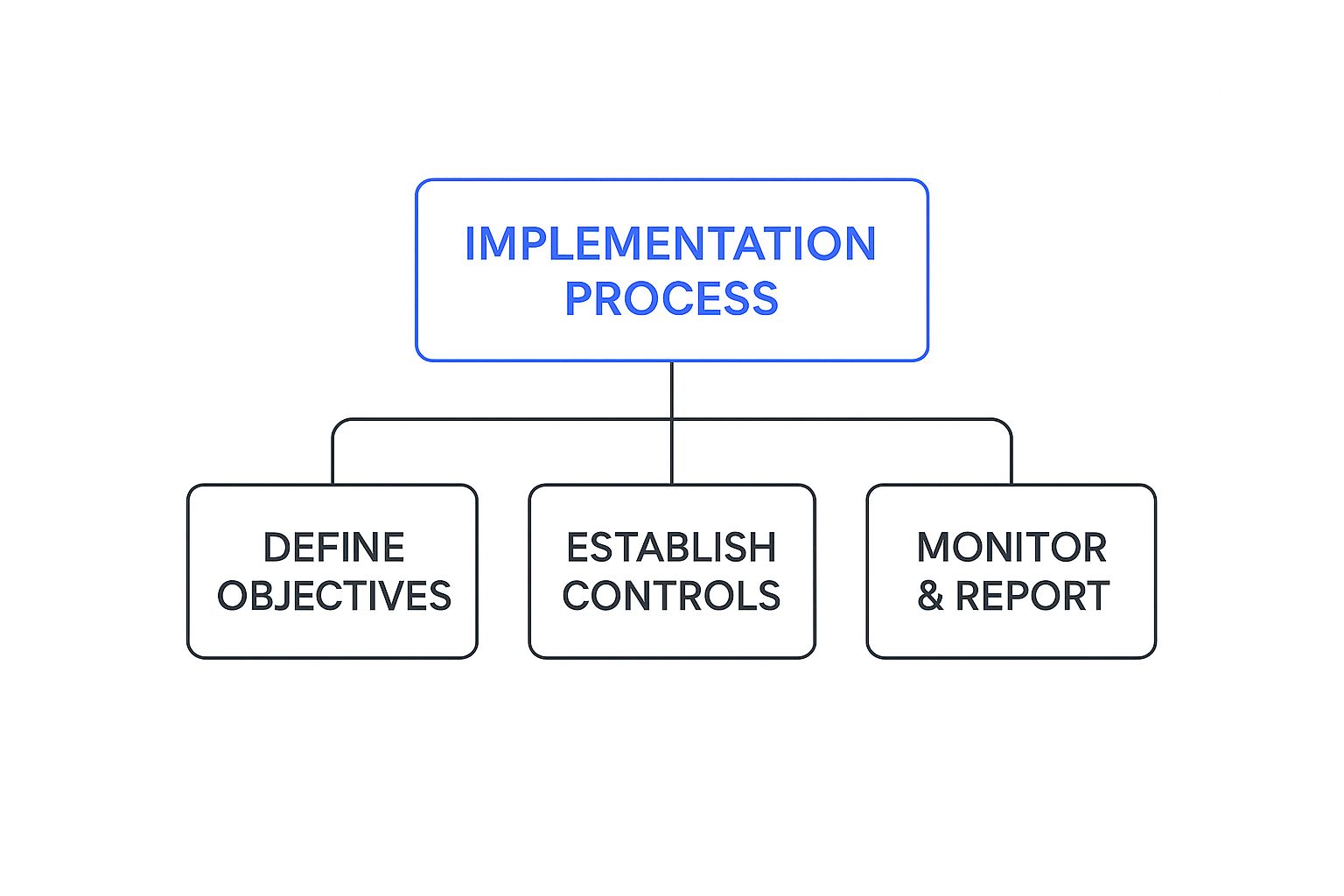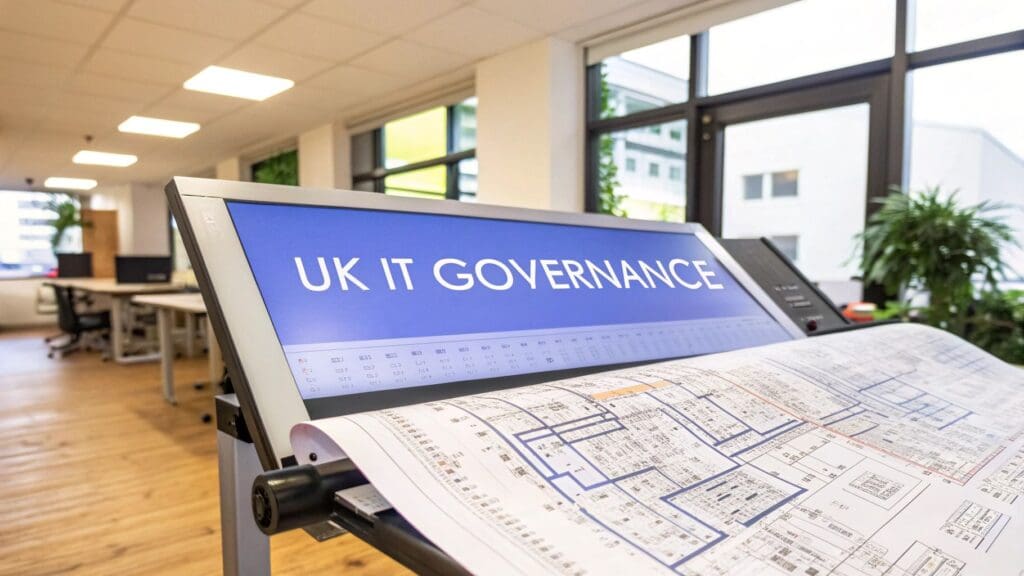An IT governance framework is essentially the rulebook that connects your technology strategy to your actual business goals. For UK businesses, it's the master guide that makes sure tech investments are actually delivering value, risks are under control, and you’re compliant with crucial regulations like the UK GDPR.
Think of it as the blueprint for your entire digital operation.
Why Your Business Needs an IT Governance Framework

Imagine trying to build a modern skyscraper without any blueprints, building codes, or a project manager. The result would be a chaotic, unsafe, and almost certainly doomed project. This is exactly what it’s like to run a modern business without an IT governance framework, especially in the competitive and highly regulated UK market.
These days, your technology isn't just a background utility; it's the very engine driving your growth, creativity, and client delivery. An IT governance framework provides the "blueprints" to ensure every digital component—from data security policies to new software rollouts—is built safely, works seamlessly with everything else, and directly supports your strategic goals.
This isn’t about adding layers of restrictive bureaucracy. It’s about providing clear, sensible rules of the road for how technology is chosen, managed, and secured.
From Cost Centre to Strategic Partner
Without formal governance, IT departments often get stuck being seen as a cost centre—a necessary expense just to keep the lights on. Decisions become reactive, focused on fixing problems as they pop up instead of proactively building value. It's an inefficient and risky way to operate, leaving a business wide open to cyber threats, compliance fines, and wasted investments.
A well-defined IT governance framework flips this script entirely. It transforms your IT function from a reactive support team into a strategic partner that actively drives business success. For any UK business, getting this right is crucial for managing both risk and stakeholder expectations.
Here’s what that looks like in practice:
- Clearer Decision-Making: It establishes who is responsible for IT decisions, ensuring they align with business priorities, not just what’s technically convenient.
- Enhanced Security and Compliance: It provides a structured approach to meeting legal duties, like the UK GDPR and NIS Regulations, cutting the risk of eye-watering fines.
- Improved Return on Investment (ROI): It makes sure every pound spent on tech is justified and tied to specific business outcomes, helping to eliminate redundant systems and wasteful spending.
- Better Risk Management: It gives you a system for identifying and mitigating threats, from cybersecurity attacks to data loss, protecting your reputation and your clients' valuable work.
An effective IT governance framework ensures that technology doesn't just work—it works towards a specific purpose. It’s the bridge between what your business wants to achieve and how technology will help you get there.
The 5 Pillars of IT Governance
To really get your head around how this all fits together, it helps to break it down into its core components. These five pillars form the foundation of any solid framework, giving you the structure needed to manage technology effectively across the whole organisation.
Here's a quick overview of what those pillars do.
The 5 Pillars of IT Governance
| Pillar | Core Function |
|---|---|
| Strategic Alignment | Ensures your IT strategy is directly linked to your business strategy, making technology a driver of your goals. |
| Value Delivery | Focuses on making sure IT projects deliver the promised benefits, optimising costs and proving the value of tech investments. |
| Risk Management | Involves identifying, assessing, and mitigating IT-related risks to protect company assets and ensure business continuity. |
| Resource Management | Ensures all IT resources—including people, infrastructure, and budget—are managed efficiently and allocated effectively. |
| Performance Measurement | Involves monitoring and evaluating IT performance against set goals using clear metrics, enabling continuous improvement. |
For any UK business—and especially creative studios handling sensitive client data—adopting an IT governance framework isn’t just good practice. It's essential for survival and growth. It's the mechanism that provides control, security, and a clear path to gaining a real competitive edge.
Navigating UK Compliance and Cybersecurity Demands

For any business in the UK, the conversation around IT governance is no longer just about being efficient. It's now driven by serious legal and regulatory pressure. The days of treating data protection and cybersecurity as an afterthought are well and truly over.
Get it wrong, and you’re not just looking at a slap on the wrist. You’re facing the real risk of multi-million-pound fines, catastrophic reputational damage, and a complete loss of client trust.
This new reality means a formal IT governance framework has gone from a ‘nice-to-have’ to an essential toolkit for survival. It gives you the structure, policies, and controls needed to prove you’re doing the right thing and protects your business from the hefty penalties UK regulators are more than willing to enforce. Without a structured approach, you're just firefighting legal risks with inconsistent, makeshift processes—a dangerous and frankly unsustainable way to operate.
The Heavy Weight of UK Regulations
Several key pieces of legislation form the bedrock of the UK’s compliance landscape, and all demand solid IT governance. These aren't abstract rules; they have real teeth and apply to a massive number of organisations, including creative studios that handle personal data or provide digital services.
The UK General Data Protection Regulation (UK GDPR) requires organisations to implement 'appropriate technical and organisational measures' to protect personal data. The penalties for non-compliance are severe, with fines of up to £17.5 million or 4% of annual global turnover.
Furthermore, the Network and Information Systems (NIS) Regulations mandate that organisations classed as Operators of Essential Services or Relevant Digital Service Providers have strong IT governance, including robust security measures and mandatory incident reporting. The Data Protection and Digital Information Bill also aims to update the UK’s data protection framework, reinforcing the need for clear governance structures.
At its core, UK compliance is all about demonstrating control. Regulators like the Information Commissioner's Office (ICO) need to see that you have a deliberate, documented, and repeatable system for managing information risk. An IT governance framework is the single most effective way to provide that proof.
A Framework as Your Compliance Shield
Trying to get your head around these regulations can feel overwhelming, but an IT governance framework acts as your shield. It translates dense legal jargon into practical, manageable actions for your team.
Here’s how a proper governance structure helps you meet these specific UK demands:
- UK GDPR Compliance: A framework sets out clear policies for how data is handled, processed, and stored. It defines who is responsible for what, ensuring someone is accountable for data protection, and mandates vital processes like Data Protection Impact Assessments (DPIAs) before you kick off new projects.
- Meeting NIS Regulations: For those who fall under these rules, a framework provides the necessary risk assessment procedures and security controls. It also creates the incident response plans you need to detect, manage, and report security breaches within the tight deadlines set by the regulations.
- Demonstrating Due Diligence: If a breach ever happens, a well-documented IT governance framework is your best defence. It lets you show the ICO that you took reasonable, proactive steps to protect your systems and data.
This structured approach isn't just about dodging fines. It builds a culture of security and responsibility inside your organisation, which is fundamental for keeping clients happy long-term.
For creative businesses, understanding the nuances of these standards is key to building a resilient operation. You can learn more about making compliance work for you by reading our guide on navigating IT standards without the chaos. In today's climate, proving you can protect client data is every bit as important as the creative work you deliver.
Choosing the Right IT Governance Framework
With so many frameworks out there, picking the right one for your UK business can feel a bit overwhelming. The secret is to realise they aren't one-size-fits-all solutions. It’s better to think of them as different toolkits, each built to solve a particular set of problems.
Your job is to find the toolkit that best fits your organisation's size, industry, and what you’re trying to achieve strategically. For a creative studio in the UK, that might mean focusing on protecting client data and keeping services reliable. A massive financial institution, on the other hand, might be more concerned with enterprise-wide risk management and resource optimisation.
This clean hierarchy diagram shows the fundamental steps of the implementation process: defining objectives, establishing controls, and monitoring progress.

As the diagram shows, a successful IT governance framework isn't a one-and-done setup. It’s a continuous cycle of improvement.
COBIT: A Business-Focused Approach
COBIT (Control Objectives for Information and Related Technologies) is widely seen as the most comprehensive IT governance framework. It’s built to give you a complete, end-to-end view of your company’s IT, making sure everything tech-related lines up with your business goals.
Think of COBIT as the master blueprint for your organisation's entire technology ecosystem. It doesn't just look at security or service delivery in isolation; it helps the leadership team ask and answer the big questions, like, "Are our IT investments actually delivering value?" and "Are we properly managing our digital risks?"
Its main strengths really shine through in a few areas:
- Strategic Alignment: It’s brilliant at connecting high-level business objectives directly to specific IT processes and controls.
- Holistic Coverage: It covers the lot—from risk and resource management to performance measurement. This makes it a great fit for larger, more complex organisations.
- Value Optimisation: COBIT is laser-focused on making sure IT delivers measurable benefits and a solid return on investment.
For any UK business that needs to show robust oversight to stakeholders, regulators, or the board, COBIT provides a powerful and highly respected structure to do just that.
Cyber Essentials: The UK Government-Backed Standard
For UK businesses, especially small and medium-sized enterprises (SMEs), Cyber Essentials is an excellent and highly recommended starting point. Backed by the UK government, it's a simple yet effective scheme designed to help organisations protect themselves against a whole range of the most common cyber attacks.
It isn't a full governance framework like COBIT, but it provides a foundational layer of security controls that align perfectly with the principles of good governance. Certification also demonstrates a commitment to cybersecurity, which is often a requirement for government contracts.
Adopting Cyber Essentials is a practical first step towards building a robust security culture. It provides a clear, achievable baseline that addresses key vulnerabilities and helps meet compliance obligations under UK GDPR.
This framework is less about grand business strategy and more about the essential, hands-on controls you need to keep your business secure. That makes it an excellent, accessible choice for organisations looking to quickly improve their security posture and build trust with UK-based clients and partners.
ISO/IEC 27001: The Security Cornerstone
While Cyber Essentials provides a strong foundation, the ISO/IEC 27000 series—and specifically ISO/IEC 27001—is the global gold standard for creating, implementing, and maintaining an Information Security Management System (ISMS).
An ISMS is a systematic approach to managing sensitive company information, whether that’s client data, intellectual property, or employee records. For any UK business handling personal data under UK GDPR, achieving ISO 27001 certification is a clear, powerful statement that you take data protection seriously. Many UK organisations use Cyber Essentials as a stepping stone towards the more comprehensive controls required by ISO 27001.
ITIL: The Service Management Specialist
Finally, we have ITIL (Information Technology Infrastructure Library). Unlike the others, ITIL isn't strictly a governance framework. It’s really a set of best practices focused squarely on IT Service Management (ITSM).
Its whole purpose is to make sure your IT services are delivered consistently, reliably, and efficiently. ITIL lays out detailed processes for managing incidents, handling service requests, and rolling out changes to your systems with minimal disruption. Many find that bringing in a third party helps put these principles into practice effectively. For more on this, you can explore the essential features of a superior managed service provider who can get these processes working for you.
Ultimately, these frameworks aren't mutually exclusive. In fact, many UK businesses take a hybrid approach, starting with Cyber Essentials, then blending the security focus of ISO 27001 with the operational rigour of ITIL. This lets them create a system that’s both robust and perfectly suited to their needs.
How to Launch Your IT Governance Framework

Starting the journey to implement an IT governance framework can feel like a monumental task. The key is to avoid trying to do everything at once. Instead, think of it as a series of manageable, logical steps, not a single, giant leap.
This practical roadmap will guide you through launching a framework without the overwhelm, focusing on delivering tangible value from day one. By breaking the process down, you can build momentum and show success quickly.
A successful rollout isn't about top-down enforcement; it's about building a shared understanding of why these changes matter. This means securing buy-in, communicating clearly, and focusing on the areas that pose the biggest risks and offer the greatest rewards.
Stage 1: Assemble Your Governance Team
Before writing a single policy, your first and most critical step is getting the right people on board. An IT governance framework driven solely by the IT department is destined to fail. It must be championed by business leadership to have any real authority.
You need executive sponsorship from the very beginning. This senior-level backing sends a clear message that governance is a business priority, not just another tech project. This person will be your advocate, helping to remove obstacles and secure the resources you need.
Next, pull together a dedicated governance team or committee. This group has to be cross-functional, representing not just IT but also key business areas like operations, finance, and legal. For a UK business, including someone familiar with UK GDPR and other local regulations is a must. This diverse team ensures the framework addresses real-world business needs rather than being cooked up in a technical silo.
Stage 2: Assess Your Current Situation
You can't draw a map without knowing your starting point. The next stage involves a frank analysis of your current IT environment to find your biggest gaps and highest-risk areas. This isn't about finding fault; it's about gaining clarity.
Conduct a current-state analysis by asking some tough questions:
- Where are our biggest risks? Think about data security, compliance with UK regulations, and operational reliability.
- What processes are already in place? You might have informal controls that can be formalised and strengthened.
- Where is the business feeling the most pain? Are there frequent system outages, data access issues, or creeping anxiety about cybersecurity?
This assessment will give you a clear, honest picture of your strengths and weaknesses. It provides the evidence you need to prioritise your efforts, ensuring you tackle the issues that matter most to the business first.
A common mistake is to aim for a perfect, all-encompassing framework from the get-go. A far better approach is to identify your top three risks and build your initial governance efforts around mitigating them. For many UK businesses, starting with the Cyber Essentials controls is a pragmatic first step.
Stage 3: Create a Phased Implementation Plan
Armed with your assessment, you can now build a realistic implementation plan. The golden rule here is to avoid a 'big bang' approach. Trying to implement an entire framework like COBIT or ISO 27001 in one go is a recipe for disaster, leading to resistance and burnout.
Instead, adopt a phased rollout. Your current-state analysis will have highlighted the most urgent priorities. For most UK businesses, this often means starting with controls related to risk management and data protection to align with the UK GDPR.
Your phased plan should look something like this:
- Phase One (Months 1-3): Focus on foundational controls. Implement the five technical controls of Cyber Essentials and create a formal risk register.
- Phase Two (Months 4-6): Build on your initial success. You might introduce change management processes or formalise IT procurement policies to control costs and reduce shadow IT.
- Phase Three (Months 7-12): Expand the framework's scope. This could involve deeper dives into resource management, performance measurement, or starting the journey towards ISO 27001 certification.
This iterative process allows you to learn and adapt as you go, making the whole initiative much more manageable and sustainable.
Stage 4: Communicate and Measure
Finally, no framework can succeed without clear communication and measurable results. You need to articulate the 'why' behind the new processes to everyone in the organisation, from the leadership team down to every single employee.
Develop a simple communication plan that explains the benefits of the new IT governance framework. Explain how it will make their jobs easier, protect the company, and safeguard client data. Use town hall meetings, newsletters, and team briefings to keep everyone in the loop.
At the same time, define clear metrics to track your progress and prove the framework's value. These shouldn't be overly technical.
Focus on metrics that resonate with the business:
- A reduction in the number of security incidents.
- Improved system uptime and reliability.
- Faster recovery times after an outage.
- Positive feedback from compliance audits.
By tracking and reporting on these metrics, you create a feedback loop that demonstrates the tangible benefits of your governance efforts. This not only justifies the investment but also builds the momentum needed to continue maturing your framework over time.
The Future of IT Governance in the UK
The world of IT governance isn't a fixed, dusty rulebook; it’s constantly being rewritten by new technology and changing regulations. For any UK organisation, looking ahead means getting ready for a future where data innovation—especially Artificial Intelligence (AI)—isn’t just a nice-to-have but a core part of how you operate. This shift calls for a much more dynamic and forward-thinking IT governance framework.
A rigid, backward-looking approach will become a liability almost overnight. The future demands a strategy that can balance rapid innovation with the non-negotiable principles of security, ethics, and compliance. Your governance needs to be flexible enough to welcome new tech while still having strong guardrails in place to protect your business and your clients.
The Rise of AI and Data-Driven Governance
AI is no longer a concept on the horizon. It’s here, and it’s bringing a whole new set of complex governance challenges with it. The UK government sees this clearly, placing AI and data right at the centre of its national technology strategy.
The government's pro-innovation approach to AI regulation aims to build public trust and clarify accountability without stifling growth. Meanwhile, the Information Commissioner’s Office (ICO) provides guidance on how data protection principles apply to AI, pushing for privacy to be baked into AI systems from the ground up. This is all part of a broader UK strategy to modernise its IT governance framework by creating systems for secure and ethical data use.
This wave of national strategy and regulation sends a clear message to your business. We're moving towards "governance by design," where ethical thinking and data protection aren't afterthoughts but are built into your technology from day one.
The real challenge for future IT governance is creating a framework that enables innovation, rather than stifling it. It must be a system that empowers your team to experiment with new tools like AI responsibly, with clear guidelines on data usage, ethical boundaries, and accountability.
Building a Future-Proof Framework
So, what does this all mean for your organisation today? It means you need to start building an IT governance framework that is agile, forward-looking, and resilient. Sticking to old methods while technology sprints ahead is a surefire way to get left behind by competitors and, even worse, get on the wrong side of new regulations.
Here are the key pillars of a future-proof strategy:
- Embrace Agile Governance: Ditch the rigid, annual reviews. Move to a model of continuous monitoring and adaptation, allowing your policies to evolve in step with new technologies and business risks.
- Prioritise Data Ethics: Don't just aim for compliance. Establish a clear ethical code for how your organisation uses data, especially with AI. This builds genuine trust with clients and stakeholders.
- Focus on Digital Identity: As the UK government formalises frameworks for digital verification (such as the UK digital identity and attributes trust framework), having secure and reliable ways to manage digital identities will become absolutely critical for secure operations.
Getting ahead of these changes is what will give you a real competitive edge. By building a flexible framework now, you position your organisation to adapt swiftly to the top IT issues facing UK businesses, ensuring you stay compliant, secure, and ready for whatever comes next.
UK IT Governance Framework FAQs
When you start digging into IT governance frameworks, a lot of questions pop up. It's completely normal. For UK businesses trying to get the balance right between compliance, security, and actually getting creative work done, it can feel a bit overwhelming. Here are some straightforward answers to the questions we hear most often.
Which IT Governance Framework is Best for a Small UK Business?
Honestly, there’s no single “best” framework that fits everyone. Most smaller UK businesses we work with don't start by swallowing a massive rulebook whole. Instead, they take a practical approach.
A great starting point is the UK government-backed Cyber Essentials scheme. It’s not a full-blown governance framework, but it covers the fundamental security controls every business needs. From there, you can cherry-pick useful controls from bigger players like ISO/IEC 27001 or use guidance from COBIT to add more structure where it counts—like protecting data to align with UK GDPR.
How Long Does It Take to Implement a Framework?
This really depends on the size and complexity of your organisation. If you're a small, nimble team, you could achieve Cyber Essentials certification in as little as one to three months.
For a larger or more complex organisation aiming for full-on COBIT or ISO 27001 certification, you’re realistically looking at 12-18 months, maybe even longer. The secret is to not try and do it all at once. A phased approach that tackles the highest-risk areas first means you start seeing the benefits much sooner.
What is the Difference Between IT Governance and IT Management?
It’s simpler than it sounds. Think of it like this: governance decides where the ship is going, and management is in the engine room making it happen.
- IT Governance is the big-picture stuff, handled by the board and senior leaders. They set the destination—the strategic goals, policies, and the "what" and "why" of using technology to support the business.
- IT Management is the hands-on, operational side. This is the day-to-day work of planning, building, and running the IT services to actually reach the destination set by governance. It’s all about the "how."
In short, governance draws the map and writes the rulebook. Management plays the game and follows the route.
At InfraZen Ltd, we demystify IT governance for creative agencies across the UK, implementing quiet, effective frameworks that protect your work without stifling creativity. Discover how our human-centred approach can secure your studio.

